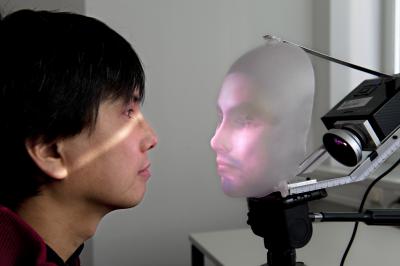Science Fiction
Dictionary
A B C D E F G H I J K L M N O P Q R S T U V W X Y Z
Mask-bot Robot Human Face

Mask-bot is a prototype robot face created at Institute for Cognitive Systems (ICS) at Germany's TU München by Dr. Takaaki Kuratate.

(Dr. Takaaki Kuratate and his robot communication interface Mask-Bot)
Many comparable systems project faces onto the front of a mask – following the same concept as cinema projection. "Walt Disney was a pioneer in this field back in the 1960s," explains Kuratate. "He made the installations in his Haunted Mansion by projecting the faces of grimacing actors onto busts." Whereas Walt Disney projected images from the front, the makers of Mask-bot use on-board rear projection to ensure a seamless face-to-face interaction.This means that there is only a twelve centimeter gap between the high-compression, x0.25 fish-eye lens with a macro adapter and the face mask. The CoTeSys team therefore had to ensure that an entire face could actually be beamed onto the mask at this short distance. Mask-bot is also bright enough to function in daylight thanks to a particularly strong and small projector and a coating of luminous paint sprayed on the inside of the plastic mask. "You don't have to keep Mask-bot behind closed curtains," laughs Kuratate.
This part of the new system could soon be deployed in video conferences. "Usually, participants are shown on screen. With Mask-bot, however, you can create a realistic replica of a person that actually sits and speaks with you at the conference table. You can use a generic mask for male and female, or you can provide a custom-made mask for each person," explains Takaaki Kuratate.
In order to be used as a robot face, Mask-bot must be able to function without requiring a video image of the person speaking. A new program already enables the system to convert a normal two-dimensional photograph into a correctly proportioned projection for a three-dimensional mask. Further algorithms provide the facial expressions and voice.
To replicate facial expressions, Takaaki Kuratate developed a talking head animation engine – a system in which a computer filters an extensive series of face motion data from people collected by a motion capture system and selects the facial expressions that best match a specific sound, called a phoneme, when it is being spoken. The computer extracts a set of facial coordinates from each of these expressions, which it can then assign to any new face, thus bringing it to life. Emotion synthesis software delivers the visible emotional nuances that indicate, for example, when someone is happy, sad or angry.
SF movie fans are reminded of the robots depicted in the 2004 film I, Robot directed by Alex Proyas, based on Isaac Asimov's eponymous short-story collection. Take a look at this short excerpt showing Sonny, the most expressive of robots.
From Eurekalert.
Scroll down for more stories in the same category. (Story submitted 11/29/2011)
Follow this kind of news @Technovelgy.| Email | RSS | Blog It | Stumble | del.icio.us | Digg | Reddit |
Would
you like to contribute a story tip?
It's easy:
Get the URL of the story, and the related sf author, and add
it here.
Comment/Join discussion ( 1 )
Related News Stories - (" Robotics ")
Proof Of Robothood - Not A Person
'Who are you people? - Show 'em.' - James Cameron (1984).
Dancing Robots Taught Dance Moves
'A clockwork figure would be the thing for you...' Jerome K. Jerome, 1893.
Factory Humanoid Robots Built By Humanoid Robots
'...haven't you a section of the factory where only robot labor is employed?' - Isaac Asimov (1940).
Mornine Sales Robot
'Robot-salesmen were everywhere, gesturing...' - Philip K Dick, 1954.
Technovelgy (that's tech-novel-gee!) is devoted to the creative science inventions and ideas of sf authors. Look for the Invention Category that interests you, the Glossary, the Invention Timeline, or see what's New.
Science Fiction
Timeline
1600-1899
1900-1939
1940's 1950's
1960's 1970's
1980's 1990's
2000's 2010's
Current News
Sunday Robotics 'Memo
'He then started hand movements of definite pattern...'
Woman Marries Computer, Vonnegut's Dream Comes True
'Men are made of protoplasm... Lasts forever.'
Natural Gait With Prosthetic Connected To Nervous System
'The leg was to function, in a way, as a servo-mechanism operated by Larry’s brain...'
Spidery 'Walk Me' Toyota Autonomous Wheel Chair Like Star Wars
Walk along with the emperor.
Dancing Robots Taught Dance Moves
'A clockwork figure would be the thing for you...'
Proof Of Robothood - Not A Person
'Who are you people? - Show 'em.'
Indonesian Clans Battle
'The observation vehicle was of that peculiar variety used in conveying a large number of people across rough terrain.'
The 'Last Mile' In China Crowded With Delivery Robots
Yes, it's a delivery robot. On wheels.
Tornyol Microdrone Kills Mosquitoes
'The real border was defended by... a swarm of quasi-independent aerostats.'
PLATO Spacecraft, Hunter Of Habitable Planets, Now Ready
'I ... set my automatic astronomical instruments to searching for a habitable planet.'
Factory Humanoid Robots Built By Humanoid Robots
'...haven't you a section of the factory where only robot labor is employed?'
iPhone Air Fulfils Jobs' Promise From 2007 - A Giant Screen!
'... oblongs were all over the floor and surfaces.'
ChatGPT Now Participates in Group Chats
'...the city was their laboratory in human psychology.'
iPhone Pocket All Sold Out!
'A long, strong, slender net...'
Did The Yautja Have These First?
What a marvel of ingenuity the little device was!
Jetson ONE Air Races Begin, Can Air Polo Be Far Behind?
'If you're one of those rarities who haven't attended a rocket-polo "carnage", let me tell you it's a colorful affair.'
